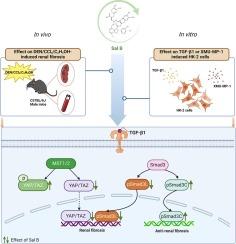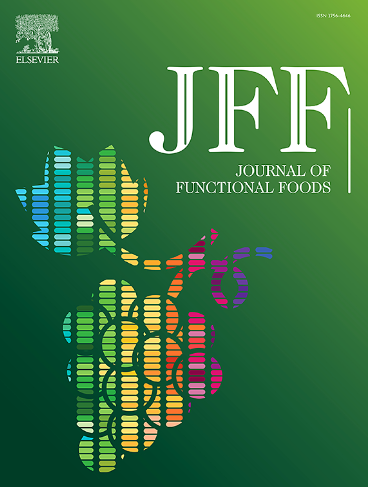Salvianolic acid B improves DEN/CCl4/C2H5OH-induced renal fibrosis by regulating YAP/TAZ and pSmad3C/pSmad3L
IF 3.8
2区 农林科学
Q2 FOOD SCIENCE & TECHNOLOGY
引用次数: 0
Abstract
Salvianolic acid B (Sal B) is a natural compound extracted from the root of Salvia miltiorrhiza, which has multiple biological activities. Targeting Hippo pathway transcriptional coactivators YAP/TAZ combined with Smad3 is an effective strategy against renal fibrosis. However, whether Sal B improves DEN/CCl4/C2H5OH-induced renal fibrosis and regulates YAP/TAZ and Smad3 phospho-isoform, pSmad3C/pSmad3L is unknown. Presently, we used DEN/CCl4/C2H5OH to induce renal fibrosis in mice and TGF-β1 or MST1/2 inhibitor XMU-MP-1 to induce HK-2 cells to investigate the activity and molecular mechanisms of Sal B. The results demonstrated that Sal B ameliorated DEN/CCl4/C2H5OH-induced renal fibrosis, including reducing renal tissue injury, improving renal function, and decreasing collagen synthesis. Furthermore, Sal B downregulated YAP/TAZ and promoted their phosphorylation in vivo and in vitro. Moreover, Sal B upregulated pSmad3C but downregulated pSmad3L in vivo and in vitro. Collectively, this study revealed that Sal B may improve DEN/CCl4/C2H5OH-induced renal fibrosis by regulating YAP/TAZ and pSmad3C/pSmad3L.

丹酚酸B通过调节YAP/TAZ和pSmad3C/pSmad3L改善DEN/CCl4/C2H5OH诱导的肾纤维化
丹酚酸 B(Sal B)是从丹参根中提取的一种天然化合物,具有多种生物活性。靶向Hippo通路转录辅激活因子YAP/TAZ和Smad3是一种有效的抗肾脏纤维化策略。然而,Sal B是否能改善DEN/CCl4/C2H5OH诱导的肾脏纤维化并调节YAP/TAZ和Smad3磷酸化异构体pSmad3C/pSmad3L尚不清楚。目前,我们用DEN/CCl4/C2H5OH诱导小鼠肾脏纤维化,并用TGF-β1或MST1/2抑制剂XMU-MP-1诱导HK-2细胞,研究Sal B的活性和分子机制。结果表明,Sal B能改善DEN/CCl4/C2H5OH诱导的肾脏纤维化,包括减轻肾组织损伤、改善肾功能和减少胶原合成。此外,Sal B还能下调YAP/TAZ,并促进它们在体内和体外的磷酸化。此外,在体内和体外,Sal B 上调 pSmad3C,但下调 pSmad3L。总之,本研究揭示了Sal B可通过调节YAP/TAZ和pSmad3C/pSmad3L改善DEN/CCl4/C2H5OH诱导的肾脏纤维化。
本文章由计算机程序翻译,如有差异,请以英文原文为准。
求助全文
约1分钟内获得全文
求助全文
来源期刊

Journal of Functional Foods
FOOD SCIENCE & TECHNOLOGY-
CiteScore
9.60
自引率
1.80%
发文量
428
审稿时长
76 days
期刊介绍:
Journal of Functional Foods continues with the same aims and scope, editorial team, submission system and rigorous peer review. We give authors the possibility to publish their top-quality papers in a well-established leading journal in the food and nutrition fields. The Journal will keep its rigorous criteria to screen high impact research addressing relevant scientific topics and performed by sound methodologies.
The Journal of Functional Foods aims to bring together the results of fundamental and applied research into healthy foods and biologically active food ingredients.
The Journal is centered in the specific area at the boundaries among food technology, nutrition and health welcoming papers having a good interdisciplinary approach. The Journal will cover the fields of plant bioactives; dietary fibre, probiotics; functional lipids; bioactive peptides; vitamins, minerals and botanicals and other dietary supplements. Nutritional and technological aspects related to the development of functional foods and beverages are of core interest to the journal. Experimental works dealing with food digestion, bioavailability of food bioactives and on the mechanisms by which foods and their components are able to modulate physiological parameters connected with disease prevention are of particular interest as well as those dealing with personalized nutrition and nutritional needs in pathological subjects.
 求助内容:
求助内容: 应助结果提醒方式:
应助结果提醒方式:


